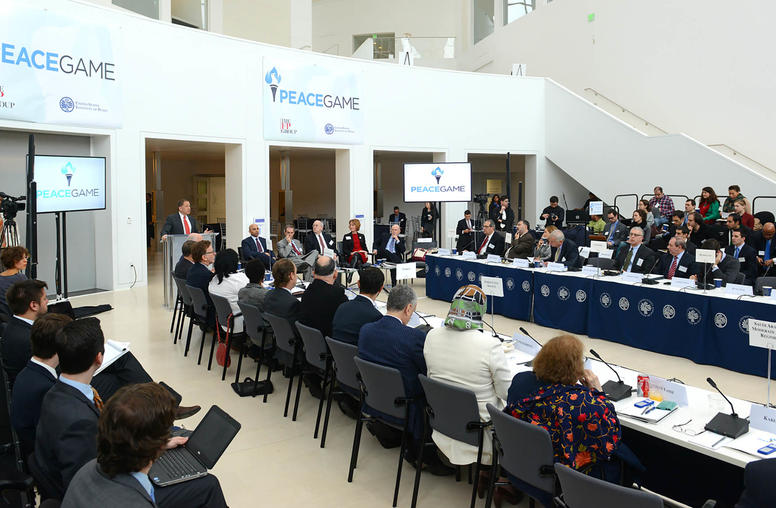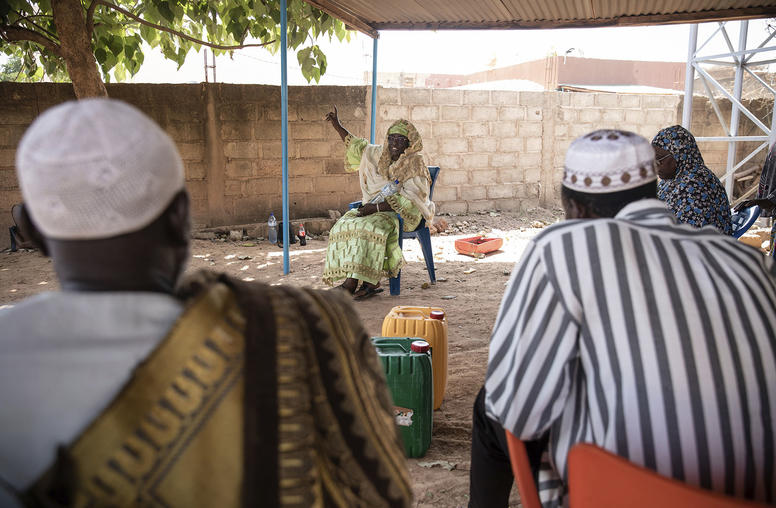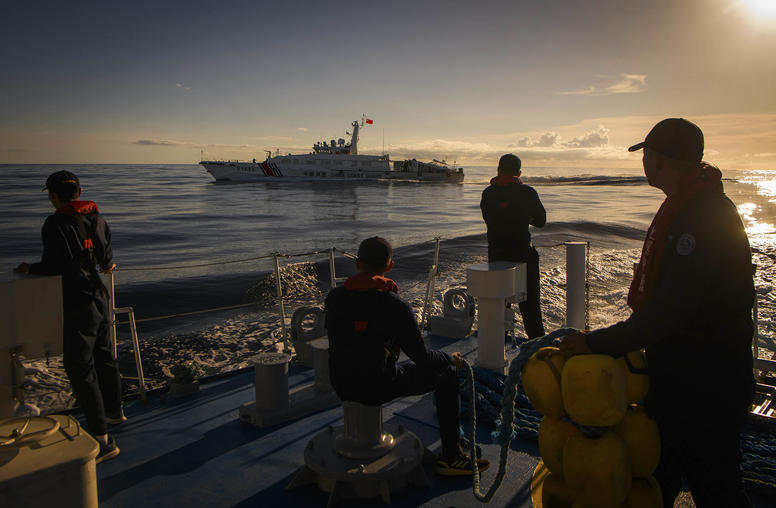Diplomats, Aid Workers Must Take Risks to Reduce Conflict, New U.S. Blueprint Says
America’s new diplomatic and foreign-aid blueprint places top priority on the need to prevent and resolve violent conflict and strengthen governance in an effort to restore a measure of global stability. But to accomplish those objectives, the plan’s authors also stressed that U.S. government agencies, together with Congress, must directly accept and address the inherent risks to the civilian workers who carry out those missions.
“The world is full of serious threats right now,” cautioned Tom Perriello, a former member of Congress from Virginia and expert on transitional justice who served as special representative to lead the Quadrennial Diplomacy and Development Review (QDDR). Perriello was part of a panel of five State Department and U.S. Agency for International Development (USAID) officials at USIP on April 30 in laying out the new roadmap. The meeting was the first formal discussion of the final report with leading national security experts and practitioners.
“The single most salient difference between the countries that succeed and those that fail is about governance.”
While “unprecedented growth of the global middle class” has pulled many people out of extreme poverty, the world still suffers the consequences of endemic poverty, “radical inequality,” corruption, the spread of diseases such as Ebola, and extremist threats such as the self-styled “Islamic State” militant group, Perriello said. Many of these scourges hit particularly hard among women and children. “When American diplomacy and development is done well, lives are saved,” he said.
The 2015 QDDR, released the previous day by Secretary of State John Kerry, proposes recommendations to improve the effectiveness and ability of U.S. diplomats and development workers to resolve the world’s most critical, complex challenges. The second of its kind, the review follows the 2010 QDDR, which established development as a core pillar of American foreign policy. This year’s report outlines four strategic priorities:
- Preventing and mitigating conflict and violent extremism
- Promoting open, democratic societies
- Advancing inclusive economic growth
- Mitigating and adapting to climate change
Perriello and other panelists particularly emphasized the need for preventive efforts to stem the emergence of threats such as violent extremism, repression of democratic movements or economic, political or social fragility. Susan Reichle, Counselor to USAID, urged that diplomats and development professionals take a “much more forward-leaning and aggressive approach” to preventing violent extremism, for example, by focusing on the causes.
Building “resilient” societies capable of sustaining the pressures of extremism or uncontrollable threats such as natural disasters requires overarching support for democratic governance, panel members said. “Good governance” allows for open civil society engagement and minimizes corruption, eliminating at least some of the sources of frustration and rage that can lead to violence.
“The single most salient difference between the countries that succeed and those that fail is about governance,” said Alex Thier, USAID’s assistant to the administrator for policy, planning and learning.
Linking Repression and Conflict
Secretary of State John Kerry underscored in remarks accompanying the release of the report that “the need for better governance across the globe” underpins effective diplomacy and development. The links between government repression and violent conflict often are treated separately in foreign policy, a distinction to be addressed at an upcoming annual USIP conference with the Alliance for Peacebuilding, entitled “Peacebuilding and Democracy in a Turbulent World.”
USIP Acting Executive Vice President Bill Taylor, who moderated the QDDR discussion, noted the overlap between the new diplomacy and development priorities and the peacebuilding arena. As the nation’s conflict management center, USIP has adopted a 2014-2019 strategic plan committed to reducing violence in at least three critical countries. The State Department and USAID also are partnering with USIP to develop concrete plans for reducing violent extremism, as a follow-up to the White House Summit to Counter Violent Extremism in February.
In addition to improving governance, the four-year plan also highlights three other cross-cutting themes:
- Increasing partnerships, especially with non-governmental sectors, such as civil society leaders and entrepreneurs.
- The inherent risks to American civilians in diplomacy and development.
- Using data and technology more effectively to diagnose problems and develop solutions.
Now, more than ever, a balanced approach to the risks faced by U.S. civilians in the field is central to engagement and partnerships, which in turn are vital to successful diplomacy and development, according to the report’s authors. The plan embraces the inevitability of frontline risk as a bold statement of policy. It calls for a robust public debate between government agencies and Congress on weighing security against engagement in the field.
A year-long study at USAID and the State Department resulted in the designation of 18 countries as “non-permissive environments,” because of a combination of factors such as security, poor access to remote areas or other issues, Reichle said. The departments are using data to assess risks and determine how to address them, whether with policy guidance, training for staff or other measures.
“The risks aren’t getting any lighter,” she said.
Yet, U.S. government agencies simply cannot afford to lock their personnel behind embassy walls, panelists said, because to do so limits their ability to engage with local counterparts and partners. Because traditional government diplomacy alone cannot resolve the world’s gravest conflicts, civilians must be able to engage with civil society, faith and community leaders and others, whether on economic development, climate change, or mitigating extremist violence.
Benghazi, Knife Attack
But increased threats to Americans overseas, epitomized by the fatal attacks on a U.S. compound in Benghazi, Libya, in 2012, and the recent knife attack on U.S. Ambassador to South Korea Mark Lippert, have aggravated the tension between practitioners’ desire for close engagement with leaders and citizens on the ground and the inevitable controversy surrounding security failures.
“The response” to such attacks “must not be to withdraw,” wrote Secretary Kerry in an editorial that coincided with the QDDR release.
Similarly, Thier spoke personally about the experience of losing a colleague who was working overseas under his authority but added that diplomats and development professionals take on these risks because of a sincere commitment to their mission. Lippert, for example, made a point to return to his daily diplomacy within weeks of his assault by resuming his walks in the streets of Seoul and throwing the first pitch at a local baseball game.
Members of Congress have indicated they understand the dilemma and are willing to engage with Kerry in a frank, transparent dialogue, Perriello said. The QDDR states that the Hill discussion, along with an internal operations review, would produce standard guidance to “streamline operations and increase flexibility in dangerous environments.”
Perriello led a conversation at a recent USIP conference on how to address risk to diplomats and aid workers. Current and former diplomats, aid officials and military officers at the conference made the case that civilian agencies must embrace calculated risk as an essential element of work in the field, and then communicate those decisions to Congress and the American people more effectively.
USIP now is working with the U.S. Advisory Commission on Public Diplomacy to facilitate an interagency working group on engagement in high-threat environments. The group’s starting point is that tolerance and management of risk are fundamental to achieving U.S. foreign policy objectives.
The QDDR goals of deterring violent extremism and building resilient societies are not new concepts in American diplomacy. The report serves as a playbook, Reichle said, for the State Department and USAID to prioritize, to navigate, and to maximize their efficiency and impact. Amidst heightened risk, it is the capacity to mitigate dire threats ranging from ISIS to Ebola that makes implementing the review so urgent, Perriello said.
“We live in a world of tremendous opportunity, but also some pretty scary threats,” Perriello said. “And I think the better we do this, the better off the world is. And that’s the urgency with which I want people not just to read this report, but to help us implement it and hold us accountable to doing so.”
Sara Egozi is a program assistant for Intergovernmental Affairs at USIP.



